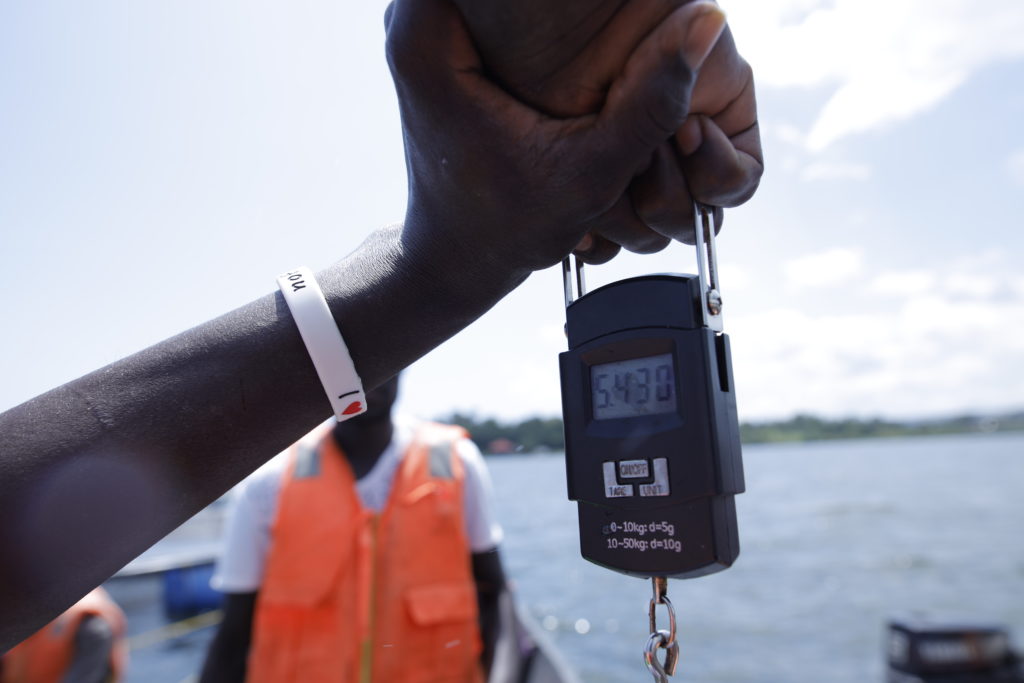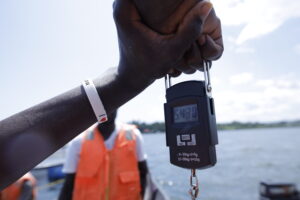What is sampling?
Sampling fish is the process of assessing the population, health and size of the fish in a specific production unit.
Why sampling is important
1. Sampling helps monitor the health and growth of the fish, allowing a farmer to identify and address any issues on time.
2. Information obtained from sampling can be used to adjust feeding rates, water quality parameters, and other management practices hence minimizing losses that may result from disease or inadequate nutrition.
3. Sampling provides valuable data about the population dynamics of the reared fish species. Farmers are able to estimate population sizes, understand growth rates, and determine the overall performance of their fish stock.
4. Sample data is crucial for making informed management decisions and maximizing the productivity and profitability of the farm.
How often should sampling be done?
Frequency of sampling depends on various factors such as the species being farmed, the stage of growth, and the objectives of the farm. Generally it is recommended to sample fingerlings at least once a month. During the early stages, more frequent sampling may be necessary to closely monitor the fingerlings’ growth and ensure they are developing as desired. As the fish mature, sampling can be conducted less frequently, but it should still be done periodically to maintain a comprehensive understanding of the population.
Sampling Equipment
- Seine net / Dip net
- Buckets
- Scoop nets
- Notebook and pen
- Water quality measuring equipment (water quality multimeter, secchi disc,..)
- Fish measuring equipment (weighing scale, measuring board, graph papers, caliper/ruler,..)
Steps of sampling fish in a pond/tank
1. Conditioning fish: Fish is not fed a day before sampling, stable water quality maintained, and minimize handling. This is meant to minimize stress and ensure more accurate results.
2. Reduce water level: reducing the water level in the pond prior to the sampling day to make seining the pond easy. Therefore, you’ll have to reduce leaving about ¼ of the original water level.
3. Seine the pond; the seine should be dragged from one end of the pond to another, and fish converge in the net most preferably at the inlet point that has fresh water.
4. Lower the net to sit on water and maintain it there as long as sampling is being done.
5. Have the buckets filled half-way with clean water, and place them on the dyke near the sampling point.
6. Measure the weight of the bucket + the water to get the initial weight
7. Scoop fish sample from the converged seine net, place in the bucket having water then weigh to get the final weight
8. Weight of fish sample is then gotten by subtracting the initial weight from the final weight (Sample weight = Final weight – Initial weight)
9. Average body weight (ABW) is the Sample weight/Number of fish sampled
For example; If 20 fish sampled weigh 400g, then ABW =(400/20) =20g
10. Fish length can also be measured by placing the sampled fish on a measuring board, then a ruler used to measure the length and girth of the fish. Fish health can also be inspected by observing the fish and recording the potential signs and symptoms of any infections.
Steps of sampling fish in a cage
1. Conditioning fish: Fish is not fed a day before sampling, stable water quality maintained, and minimize handling. This is meant to minimize stress and ensure more accurate results.
2. Concentrating fish: The inner net of the production cages. This should be done gently in order to minimize stress on fish and prevent injuring the fish. Do not fully pull out the net out of water, this is only meant to concentrate fish for easy catching of samples.
3. Catching fish samples; A net is pulled through from one end of the pulled cage net to another catching fish. Perforated buckets whose weight is known are then used to collect fish from the netting for counting and measuring
Note: To minimize stress, keep the net with concentrated fish submerged in water throughout the sampling process.
4. Buckets with collected fish are briefly weighed on a digital scale, and then the fish in the sample counted before releasing them back to water.
Weight of fish in the sample = (Weight of water+fish) – weight of empty bucket
Average body weight (ABW) is the Sample weight/Number of fish sampled
ABW = weight of fish in sample/number of fish in sample
For example; If 20 fish sampled weigh 400g, then ABW =(400/20) =20g
5. Fish length can also be measured by placing the sampled fish on a measuring board, then a ruler used to measure the length and girth of the fish.
6. Fish health can also be inspected by observing the fish and recording the potential signs and symptoms of any infections.
NB:
a) Sampling process should take a short time in order to minimize stress that would be exerted on the fish.
b) Each fish sample should be at least 15 fish. If one catch is not enough to collect this number of fish try again until enough fish are caught. In case more than 15 fish are caught, don’t throw the extra fish back. Collect all the fish caught, weigh them, and count them and record the information.
Determining total weight of fish in the pond
Use the following formula to estimate the total weight of fish in the pond.
Estimated total weight = (Average Body Weight of fish) × (Number of fish in the pond)
/*! elementor – v3.13.3 – 28-05-2023 */
.elementor-widget-image{text-align:center}.elementor-widget-image a{display:inline-block}.elementor-widget-image a img[src$=”.svg”]{width:48px}.elementor-widget-image img{vertical-align:middle;display:inline-block} 
The sample data should include the following information:
– Date of sampling
– Location of sampling
– Sampling method used
– Average Length and weight of the fingerling
– Estimated number and Total weight of fish in the culture unit
– Health status of the fish (e.g., signs of disease, parasites, etc.)




